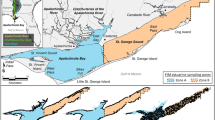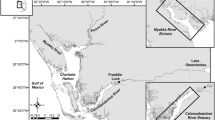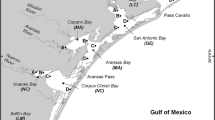Abstract
Abundance of estuarine biota can vary with freshwater inflow through several mechanisms. One proposed mechanism is that the extent of physical habitat for an estuarine species increases with flow. We estimated the contribution of variation in habitat volume to the responses of eight species of estuarine nekton to changes in freshwater flow in the San Francisco Estuary. Resource selection functions for salinity and depth were developed for each species (and for five additional species) using five monitoring data sets. The TRIM3D hydrodynamic model was run for five steady flow scenarios to determine volume by salinity and depth, and resource selection functions were used as a weighting factor to calculate an index of total habitat for each species at each flow. The slopes of these habitat indices vs. flow were consistent with slopes of abundance vs. flow for only two of the species examined. Therefore, other mechanisms must underlie responses of abundance to flow for most species.









Similar content being viewed by others
References
Aleem, A.A. 1972. Effect of river outflow management on marine life. Marine Biology 15: 200–208. doi:10.1007/BF00383550.
Armor, C., and P.L. Herrgesell. 1985. Distribution and abundance of fishes in the San Francisco Bay estuary between 1980 and 1982. Hydrobiologia 129: 211–227. doi:10.1007/BF00048696.
Bellwood, D.R., and T.P. Hughes. 2001. Regional-scale assembly rules and biodiversity of coral reefs. Science 292: 1532–1535. doi:10.1126/science.1058635.
Bennett, W.A. 2005. Critical assessment of the delta smelt population in the San Francisco Estuary, California. San Francisco Estuary and Watershed Science 3(2): Art. 1. (Online Serial) http://repositories.cdlib.org/jmie/sfews/vol3/iss2/art1.
Casulli, V. 1990. Semi-implicit finite difference methods for the two-dimensional shallow water equations. Journal of Computational Physics 86: 56–74. doi:10.1016/0021-9991(90)90091-E.
Casulli, V., and E. Cattani. 1994. Stability, accuracy and efficiency of a semi-implicit method for three-dimensional shallow water flow. Computers and Mathematics with Applications 27: 99–112. doi:10.1016/0898-1221(94)90059-0.
Cayan, D.R., and D.H. Peterson. 1993. Spring climate and salinity in the San Francisco Bay Estuary. Water Resources Research 29: 293–303. doi:10.1029/92WR02152.
Cheng, R.T., V. Casulli, and J.W. Gartner. 1993. Tidal, residual, intertidal mudflat (TRIM) model and its applications to San-Francisco Bay, California. Estuarine, Coastal, and Shelf Science 36: 235–280. doi:10.1006/ecss.1993.1016.
Cloern, J.E. 1991. Annual variations in river flow and primary production in the South San Francisco Bay estuary (USA). In Estuaries and coasts: Spatial and temporal intercomparisons, eds. M. Elliott, and J.-P. Ducrotoy, 91–96. Fredensborg: Olsen and Olsen.
Cloern, J.E., and R.T. Cheng. 1981. Simulation model of Skeletonema costatum population dynamics in northern San Francisco Bay, California. Estuarine, Coastal, and Shelf Science 12: 83–100. doi:10.1016/S0302-3524(81)80119-3.
Cloern, J.E., and F.H. Nichols. 1985. Temporal dynamics of an estuary: San Francisco Bay. Hydrobiologia. Dordrecht: Junk.
Cloern, J.E., A.D. Jassby, J.K. Thompson, and K.A. Hieb. 2007. A cold phase of the East Pacific triggers new phytoplankton blooms in San Francisco Bay. Proceedings of the National Academy of Sciences, USA 104: 18561–18565. doi:10.1073/pnas.0706151104.
Conomos, T.J. 1979. San Francisco Bay: The urbanized estuary. San Francisco: Pacific Division, American Association for the Advancement of Science.
Deegan, L.A. 1990. Effects of estuarine environmental conditions on population dynamics of young-of-the-year gulf menhaden. Marine Ecology Progress Series 68: 195–205. doi:10.3354/meps068195.
Dege, M., and L.R. Brown. 2004. Effect of outflow on spring and summertime distribution and abundance of larval and juvenile fishes in the upper San Francisco Estuary. In Early life history of fishes in the San Francisco Estuary and Watershed, eds. F. Feyrer, L.R. Brown, R.L. Brown and J.J. Orsi, 49–65. American Fisheries Society Symposium Vol. 39. Bethesda MD: American Fisheries Society.
Drinkwater, K.F., and K.T. Frank. 1994. Effects of river regulation and diversion on marine fish and invertebrates. Aquatic Conservation: Marine and Freshwater Ecosystems 4: 135–151. doi:10.1002/aqc.3270040205.
Emmett, R.L., S.L. Stone, S.A. Hinton, and M.E. Monaco. 1991. Distribution and abundance of fishes and invertebrates in west coast estuaries, volume II: Species life history summaries. NOAA/NOS Strategic Environmental Assessments Division.
Feyrer, F., T. Sommer, and W. Harrell. 2006. Managing floodplain inundation for native fish: Production dynamics of age-0 splittail (Pogonichthys macrolepidotus) in California’s Yolo Bypass. Hydrobiologia 573: 213–226. doi:10.1007/s10750-006-0273-2.
Feyrer, F., M.L. Nobriga, and T.R. Sommer. 2007. Multi-decadal trends for three declining fish species: Habitat patterns and mechanisms in the San Francisco Estuary, California, U.S.A.. Canadian Journal of Fisheries and Aquatic Sciences 64: 723–734. doi:10.1139/F07-048.
Gammelsrød, T. 1992. Variation in shrimp abundance on the Sofala Bank, Mozambique, and its relation to the Zambezi River runoff. Estuarine, Coastal, and Shelf Science 35: 91–103. doi:10.1016/S0272-7714(05)80058-7.
Gross, E.S., M.L. MacWilliams, and W. Kimmerer. 2006. Simulating periodic stratification in San Francisco Bay. Proceedings of the Ninth Estuarine and Coastal Modeling Conference, ASCE, pp. 155–175.
Guisan, A., and N.E. Zimmermann. 2000. Predictive habitat distribution models in ecology. Ecological Modelling 135: 147–186. doi:10.1016/S0304-3800(00)00354-9.
Hatfield, S.E. 1985. Seasonal and interannual variation in distribution and population abundance of the shrimp Crangon franciscorum in San Francisco Bay. Hydrobiologia 129: 199–210. doi:10.1007/BF00048695.
Hollibaugh, J.T. 1996. San Francisco Bay: the ecosystem. Further investigations into the natural history of San Francisco Bay and delta with reference to the influence of man. San Francisco: American Association for the Advancement of Science.
Houde, E.D., and E.S. Rutherford. 1993. Recent trends in estuarine fisheries—Predictions of fish production and yield. Estuaries 16: 161–176. doi:10.2307/1352488.
Jassby, A.D., W.J. Kimmerer, S.G. Monismith, C. Armor, J.E. Cloern, T.M. Powell, J.R. Schubel, and T.J. Vendlinski. 1995. Isohaline position as a habitat indicator for estuarine populations. Ecological Applications 5: 272–289. doi:10.2307/1942069.
Kaartvedt, S., and D.L. Aksnes. 1992. Does freshwater discharge cause mortality of fjord-living zooplankton. Estuarine, Coastal, and Shelf Science 34: 305–313. doi:10.1016/S0272-7714(05)80086-1.
Kerr, J.T., and I. Deguise. 2004. Habitat loss and the limits to endangered species recovery. Ecology Letters 7: 1163–1169. doi:10.1111/j.1461-0248.2004.00676.x.
Kimmerer, W.J. 2002a. Effects of freshwater flow on abundance of estuarine organisms: Physical effects or trophic linkages? Marine Ecology Progress Series 243: 39–55. doi:10.3354/meps243039.
Kimmerer, W.J. 2002b. Physical, biological, and management responses to variable freshwater flow into the San Francisco Estuary. Estuaries 25: 1275–1290. doi:10.1007/BF02692224.
Kimmerer, W.J. 2004. Open water processes of the San Francisco Estuary: from physical forcing to biological responses. San Francisco Estuary and Watershed Science (Online Serial) 2: Issue 1, Article 1. http://repositories.cdlib.org/jmie/sfews/vol2/iss1/art1.
Kimmerer, W.J. 2006. Response of anchovies dampens effects of the invasive bivalve Corbula amurensis on the San Francisco Estuary foodweb. Marine Ecology Progress Series 324: 207–218. doi:10.3354/meps324207.
Kimmerer, W.J., J.H. Cowan Jr., L.W. Miller, and K.A. Rose. 2000. Analysis of an estuarine striped bass population: Influence of density-dependent mortality between metamorphosis and recruitment. Canadian Journal of Fisheries and Aquatic Sciences 57: 478–486. doi:10.1139/cjfas-57-2-478.
Mallin, M.A., H.W. Paerl, J. Rudek, and P.W. Bates. 1993. Regulation of estuarine primary production by watershed rainfall and river flow. Marine Ecology Progress Series 93: 199–203. doi:10.3354/meps093199.
Manly, B.F.J., L.L. McDonald, D.L. Thomas, T.L. Mcdonald, and W.P. Erickson. 2002. Resource selection by animals: Statistical design and analysis for field studies. 2Dordrecht: Kluwer.
Maravelias, C.D. 1999. Habitat selection and clustering of a pelagic fish: Effects of topography and bathymetry on species dynamics. Canadian Journal of Fisheries and Aquatic Sciences 56: 437–450. doi:10.1139/cjfas-56-3-437.
Monismith, S.G., W.J. Kimmerer, J.R. Burau, and M.T. Stacey. 2002. Structure and flow-induced variability of the subtidal salinity field in northern San Francisco Bay. Journal of Physical Oceanography 32: 3003–3019. doi:10.1175/1520-0485(2002)032<3003:SAFIVO>2.0.CO;2.
Montagna, P.A., and R.D. Kalke. 1992. The effect of freshwater inflow on meiofaunal and macrofaunal populations in the Guadalupe and Nueces Estuaries, Texas. Estuaries 15: 307–326. doi:10.2307/1352779.
Moyle, P.B., B. Herbold, D.E. Stevens, and L.W. Miller. 1992. Life history and status of the delta smelt in the Sacramento–San Joaquin Estuary, California. Transactions of the American Fisheries Society 121: 67–77. doi:10.1577/1548-8659(1992)121<0067:LHASOD>2.3.CO;2.
Nichols, F., J. Cloern, S. Luoma, and D. Peterson. 1986. The modification of an estuary. Science 231: 567–573. doi:10.1126/science.231.4738.567.
Nixon, S.W., C.A. Oviatt, J. Frithsen, and B. Sullivan. 1986. Nutrients and the productivity of estuarine and coastal marine systems. Journal of the Limnological Society of South Africa 12: 43–71.
Nobriga, M., T. Sommer, F. Feyrer, and K. Fleming. 2008. Long-term trends in summertime habitat suitability for delta smelt, Hypomesus transpacificus. San Francisco Estuary and Watershed Science 6: Issue 1 Article 1.
Reaugh, M.L., M.R. Roman, and D.K. Stoecker. 2007. Changes in plankton community structure and function in response to variable freshwater flow in two tributaries of the Chesapeake Bay. Estuaries and Coasts 30: 403–417.
Riley, G.A. 1937. The significance of the Mississippi River drainage for biological conditions in the northern Gulf of Mexico. Journal of Marine Research 1: 60–74.
Rose, K.A., and J.K. Summers. 1992. Relationships among long-term fisheries abundances, hydrographic variables, and gross pollution indicators in northeastern U.S. estuaries. Fisheries Oceanography 1: 281–293. doi:10.1111/j.1365-2419.1992.tb00001.x.
Rosenfield, J.A., and R.D. Baxter. 2007. Population dynamics and distribution patterns of longfin smelt in the San Francisco Estuary. Transactions of the American Fisheries Society 136: 1577–1592. doi:10.1577/T06-148.1.
Ryan, H.F., and M.A. Noble. 2007. Sea level fluctuations in central California at subtidal to decadal and longer time scales with implications for San Francisco Bay, California. Estuarine, Coastal and Shelf Science 73: 538–550. doi:10.1016/j.ecss.2007.02.009.
Scavia, D., and others. 2002. Climate change impacts on US coastal and marine ecosystems. Estuaries 25: 149–164. doi:10.1007/BF02691304.
Schoellhamer, D.H. 2002. Variability of suspended-sediment concentration at tidal to annual time scales in San Francisco Bay, USA. Continental Shelf Research 22: 1857–1866. doi:10.1016/S0278-4343(02)00042-0.
Sin, Y., R.L. Wetzel, and I.C. Anderson. 1999. Spatial and temporal characteristics of nutrient and phytoplankton dynamics in the York River estuary, Virginia: Analyses of long-term data. Estuaries 22: 260–275. doi:10.2307/1352982.
Skreslet, S. 1986. The role of freshwater outflow in coastal marine ecosystems, NATO ASI Series G ed. Berlin: Springer.
Sommer, T., R. Baxter, and B. Herbold. 1997. Resilience of splittail in the Sacramento–San Joaquin Estuary. Transactions of the American Fisheries Society 126: 961–976. doi:10.1577/1548-8659(1997)126<0961:ROSITS>2.3.CO;2.
Sommer, T.R., W.C. Harrell, and M.L. Nobriga. 2005. Habitat use and stranding risk of juvenile Chinook salmon on a seasonal floodplain. North American Journal of Fisheries Management 25: 1493–1504. doi:10.1577/M04-208.1.
Sommer, T., and others. 2007. The collapse of pelagic fishes in the upper San Francisco Estuary. Fisheries 32: 270–277. doi:10.1577/1548-8446(2007)32[270:TCOPFI]2.0.CO;2.
Stevens, D.E. 1977. Striped bass (Morone saxatilis) year class strength in relation to river flow in the Sacramento–San Joaquin Estuary, California. Transactions of the American Fisheries Society 106: 34–42. doi:10.1577/1548-8659(1977)106<34:SBMSYC>2.0.CO;2.
Stoner, A.W., J.P. Manderson, and J.P. Pessutti. 2001. Spatially explicit analysis of estuarine habitat for juvenile winter flounder: combining generalized additive models and geographic information systems. Marine Ecology–Progress Series 213: 253–271. doi:10.3354/meps213253.
Swartzman, G., C.H. Huang, and S. Kaluzny. 1992. Spatial analysis of Bering sea Groundfish survey data using generalized additive models. Canadian Journal of Fisheries and Aquatic Sciences 49: 1366–1378. doi:10.1139/f92-152.
Turner, J.L., and H.K. Chadwick. 1972. Distribution and abundance of young-of-the-year striped bass, Morone saxatilis, in relation to river flow in the Sacramento–San Joaquin estuary. Transactions of the American Fisheries Society 101: 442–452. doi:10.1577/1548-8659(1972)101<442:DAAOYS>2.0.CO;2.
Venables, W.N., and B.N. Ripley. 2002. Modern applied statistics with S. 4New York: Springer.
Vörösmarty, C.J., P. Green, J. Salisbury, and R.B. Lammers. 2000. Global water resources: Vulnerability from climate change and population growth. Science 289: 284–288. doi:10.1126/science.289.5477.284.
Wilber, D.H. 1992. Associations between freshwater inflows and oyster productivity in Apalachicola Bay, Florida. Estuarine, Coastal, and Shelf Science 35: 179–190. doi:10.1016/S0272-7714(05)80112-X.
Wilber, D.H. 1994. The influence of Apalachicola River flows on blue crab, Callinectes sapidus, in north Florida. Fishery Bulletin 92: 180–188.
Acknowledgments
Funding for this study was provided by CALFED Bay-Delta Program Contract ERP-02-P19. We thank W. Bennett for helpful discussions. F. Feyrer and M. Weaver provided helpful comments on the manuscript.
Author information
Authors and Affiliations
Corresponding author
Rights and permissions
About this article
Cite this article
Kimmerer, W.J., Gross, E.S. & MacWilliams, M.L. Is the Response of Estuarine Nekton to Freshwater Flow in the San Francisco Estuary Explained by Variation in Habitat Volume?. Estuaries and Coasts 32, 375–389 (2009). https://doi.org/10.1007/s12237-008-9124-x
Received:
Revised:
Accepted:
Published:
Issue Date:
DOI: https://doi.org/10.1007/s12237-008-9124-x




